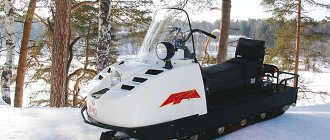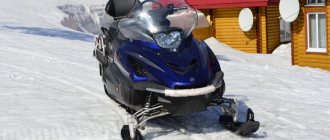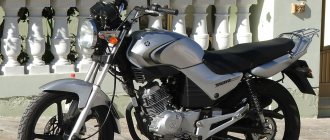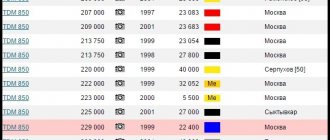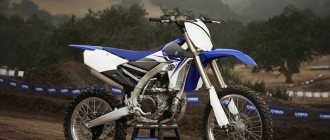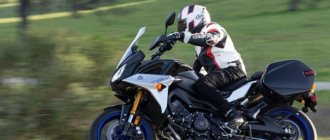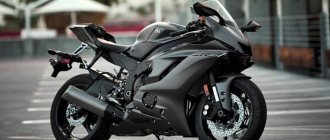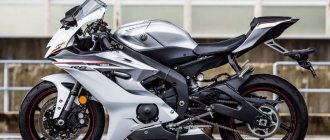What's with the names?
Fazer is not a nickname. The concern did not position the model as an export or domestic one.
Yamaha FZ-1 is the flagship model of the Phaser line, which consists of several motorcycles produced in different versions.
It was sold all over the world, but entered the markets of different countries under different names. Except for this, the buyer saw the same bike with a liter engine.
- Yamaha FZ1 - for the USA, North and South America.
- Yamaha FZS 1000 Fazer - Europe, Asia, Australian mainland.
The model was the only one in which the second generation was radically different from the first .
014_MOTO_0810_034
Typically, recommendations for choosing a specific instance begin with the words: “in addition to standard checks, the same for any motorcycle, you need to pay attention to...”. So, with regard to the Phaser, everything is exactly the opposite: “carry out the standard checks for a used motorcycle.” Fazer really doesn’t have any tricks, pitfalls or family diseases. For the same reason, there is complete peace and quiet when it comes to pricing. The range starts from approximately 160 thousand rubles. for the most well-deserved (it’s hard to say “old”) devices from 2001–2002 and it ends at 270 thousand rubles. for copies of the latest one, produced in 2005.
Specifications
The heart of the FZ1 is a short-stroke 20-valve engine from the famous YZF-R1 sports bike, which has lost 25 horsepower after afterburning.
Here are the data for the 2021 Fazer. The difference between generations, including the motor part, will be displayed in a separate section below.
An exhaust manifold.
Cooling radiator.
The same motor was used for both generations. A redesign of the version installed on the R1, the 4-stroke, 4-cylinder engine with in-line pistons produced:
- working volume - 999 cm3;
- power - 150 hp;
- number of valves - 20 (5 per cylinder);
- cooling - liquid;
- fuel supply - injector;
- ignition - electronic;
- start - electric starter, kick starter leg;
- tank volume - 21 l.
From R1 the requirement for gasoline no lower than 95 has also been carried over.
“Phaser” prefers 95 gasoline, but does not disdain 92 gasoline.
Mechanics at the service station say that this is nothing more than a marketing ploy by the company. At 92 there are no visible changes, and the price is lower, and the quality of the fuel is higher.
Transmission and clutch
Although, according to the Japanese, this unit has been redesigned, during repairs you can use parts from both the racing flagship and your own. Full interchangeability .
- 6-speed gearbox, sequential principle . The free play of the pedal is slightly greater compared to the racing pedal, but this does not affect the handling. Switching is clear, slipping is excluded.
- Chain drive.
Classic chain drive.
- Multi-disc clutch, oil bath .
Brakes
The brake system has been completely transferred from the racing version, including the fact that in the second generation the disc diameters have changed.
The front brakes are equipped with Sumitomo brake calipers, perhaps the best in this class.
Front:
- quantity - 2 disks ,
- diameter - 320 mm ;
- support - 4 pistons with radial installation .
Rear:
- quantity - 1 disk ,
- diameter – 245 mm ;
- support - 1-piston .
The rear brakes are single disc, but quite functional.
When choosing the second generation, the user had the opportunity to buy a model with ABS. It was not installed in the stock version, but was offered as an option. The highlight was the ability to turn off the system by pressing one button.
White flies have driven our horses into stalls, and we will sublimate and graphomaniac. I offer you a short review of the FZ1. The motorcycle is very popular for objective reasons, many are considering the option of buying it, so there will be another drop of information from a biased source :) The motorcycle is not the first, but the first “liter”, which scared me at first. My memory still remained of mating games with carbs, problems with starting in cold weather, etc., etc. (and even the proportions of oil in the tank surfaced from the very depths of memory...)... But I had to forget all this :) I chose slowly, in the end season 2014. The motorcycle was “under the ass”, and therefore was in no hurry. What I wanted: a road motorcycle, mainly for the city; for infrequent and short-range trips - a front fairing; power from 100 hp; injector; and the most important thing is that I like him. And I consider the last thing the most important point in buying a motorcycle! Yes, the performance characteristics must correspond, but only if it clicks in your soul - “yes”. The choice of equipment is large. Taking this into account, I immediately limited the search to a narrow range; in short, I chose Bandit 1200 (1250) or Kilophaser. Why them?.. but simply because “like” :) You ask - would I buy a Bandit? And I can boldly answer you that yes! But market conditions gave me a very successful Phaser at a good price. I rode the Bandit before purchasing, but I had to ride the Phaser only after my name was entered in the title, so to say that I objectively and thoughtfully approached the choice of motorcycle model... well, I can’t say that, but that’s bullshit. As well as all paper calculations in favor of any model. Until you have a ride... In general, for a month I looked at all the offers that appeared on these two models, sometimes looking at the Vyfer 800. One fine evening I came across a fresh advertisement for the sale of a Phaser in excellent condition for little money. And, somehow, after a couple of hours, I, with one nice girl who understands motorcycles much better than me, watch it live. In fact, after examining the motorcycle, I was summed up: “If you don’t take it now, then I’ll buy it myself.” In the morning I exchanged money for it. I bought it on a rainy day and had to return in quite normal rain. A new motorcycle, a “liter”, the road under a layer of water... but everything turned out to be not so scary. The phaser proved to be a very phlegmatic comrade at low speeds. I drove home in the range of up to 5000 rpm, it couldn’t have been calmer. It was mid-October and I managed to drive another thousand km. on a new motorcycle, but I managed to get to know it properly already in the 2015 season. So, the 2006 FZ1 is in very good condition on new Pirelli Angel GT tires, completely stock. Although no... not stock. There is high glass and spacers on the steering wheel, thanks to which it is a couple of centimeters higher. Over the winter I installed arches and short triggers. Oil Motul 7100 10W40. After the winter, the fork leaked, so the seals/boots were replaced and Motul 10W oil was added, along with the spark plugs, all other fluids, and front pads. The motorcycle was completely ready for the season :) During the 2015 season, we managed to travel 10 thousand km. Almost all of this is the hero city of Moscow and the immediate Moscow region. I went to short distances a couple of times (up to 500 km). And I was pleased with this motorcycle. Having bought it as a “pig in a poke”, having never driven it, I was right. For the mode of operation that I need (I repeat, city and short long-distance trips), the motorcycle was more than suitable. Opening 2015. Let's go by organs and systems: -Appearance : Not discussed, to each his own. I like. The front optics look a little archaic, but this is 2006. The constantly illuminated turn signals are pleasing and increase visibility in the mirrors. -Ergonomics : Quite a road fit. I am 185 cm tall and weigh around 100 kg and it is comfortable to sit on it. The saddle height is relatively low, but the saddle is wide. Therefore, short people should try it on before purchasing. After 600 the bike feels “fat”. With my height, my legs are not bent at the knees too much - the footrests are located low, it’s comfortable to hold on to the tank. You can safely drive from gas station to gas station without losing the sensitivity of parts of your body. The passenger seat... it exists, I haven’t driven there :) The instrumentation is clear, readable, there’s nothing new there. Analog large tachometer, digital speedometer, odometer, trip meter, temperature, fuel. In bright sunlight, the digital part is sometimes not very readable. At night, on the contrary, there are no problems. The fuel level sensor is no more than C grade informative. The fuel level registers decrease nonlinearly, at first slowly, then faster. When the reserve light comes on, the odometer starts counting, and a frantic search for a gas station begins. The stock triggers are long and not very comfortable. They are narrow, and when “pressing” the clutch in traffic jams for a long time, the hand begins to get tired and hurt, and besides, the clutch lever is not adjustable. The brake is adjustable over a wide range. I changed the handles to shorter, wider and fully adjustable ones. There are no more questions for this node. The mirrors are very good. Informative, perhaps the best I've ever encountered. The price to pay for this is their sheer scale. This is compensated by their high location and ease of folding. And you often have to hide them in traffic jams. Gas handle. Well, I can’t say that it’s short, not like on a sportbike, but you can’t call it long either. To unscrew the gas all the way, you will need to grab it slightly upward in advance or lower the hand slightly lower than the normal position. Considering that this movement is often accompanied by “slipping” onto the tank, everything is normal. But in the city you won’t need to turn it all the way often... or not for long. Wind protection. I will repeat that I got the bike with a high Georgian glass, so the situation, apparently, was greatly corrected. Of course, wind protection will be lost on big tourists, but driving 200 km at 160 km/h and not hurting your neck muscles is quite possible. It doesn’t really blow into your feet either, even though there’s no plastic. But water and dirt are sadness. I seem to have a hager, and some kind of tail, and the number even dangles there. But a trip in the rain will cost you laundry, alas. And most of the dirt will come from the rear. However, bots will also be removed. Here I will give Phaser the first minus. -Drygatel : If you throw out the marketing parables about Eradyn’s twin brother from your head, and they need to be thrown out, then there is enough power. The stories about the shifting of the torque bar towards the bottom should also be thrown out there. They can sing this to the owners of six hundred cubic meter rice mills. Even after a 650 cc v-twin, the bottom end is thin. It’s not that it doesn’t go… it goes, but it doesn’t tear. I will not go into the design features of the engine, I am not an engineer. Let me just say that my copy doesn’t eat oil even after 40 thousand km. mileage kept the compression normal. When I read the reviews, there were no complaints about reliability. The character of the engine is Nordic, but not without a sparkle. Up to 4 thousand rpm everything is very calm and loyal to the rider. I would even say that this is a loophole for a novice motorcyclist, but with a lot of reservations (oh, yes, holivar :). In the range of 4-7 thousand, this is good traction, confident acceleration and everything you need in the city, just right! After 7 thousand, sports genes wake up, there is a catch. Up to 11-11.5 thousand we have a smile on our face, everything is fine, there is gunpowder in the flasks. At least you don’t have to be shy about sporty six hundred and gsxr750 – checked. Up to a hundred according to the passport 3.2 s, maximum speed 269 km/h. Personal experience: about 3.8-4 and 261 respectively. Up to 230 the acceleration is good and confident, then you have to “pump” it one kilometer at a time. In general, Phaser gets a definite plus for the engine. I was satisfied with the standard exhaust (not loud, not quiet, the exap works), so this issue is not closed, but simply has not even been opened. -Consumption : A hackneyed topic. The phaser loves to eat gasoline, prefers 95, does not disdain 92. For breakfast he will eat 10 liters, for lunch another 8, and by afternoon you are already at the gas station. The tank is 18 liters with a consumption of 10 liters in the “food as I like” mode around the city. On the highway, if you drive 110-130, you can stretch it 220 km to the reserve. You can drive 35 km on reserve, I haven’t tried it again. Never had a chance to dry out. In the most economical version, this is about 8 liters per 100 km. More realistically - 10. In the mode of night rides with friends and speeding at 200 km/h, this is already 12+ l/100 km. The Phaser cannot be called economical - this is a minus (second). You can only save on oil :) -Frame : Why is the frame separate? But because on motorcycles of 2007 it bursts. You need to remember this when purchasing. And this frame is luminous, foreign, expensive... There is a list of VINs for defective frames on the Internet, if you need it, you can find it. A defective frame may or may not burst. If it bursts, this is a warranty case. Does this guarantee work in the Russian Federation? - I don’t know a word. The smoked-out specialized forum did not give a clear answer. English forums write that you need to be an avid stunter for even a defective frame to burst. In general, the topic is slippery, I have not studied it in detail. -Suspensions, brakes, handling : In my amateurish opinion, the strong point of this motorcycle. The brakes are excellent, both front and rear. I don’t have ABS, so I shout at all corners that ABS was invented by cowards and I’m only for TRU (that is, without ABS). In fact, I wouldn’t refuse ABS, but I stubbornly hide it even during interrogations with torture. This increases my skill by +1 in the “sport biker” column and at the same time -2 in the “common sense” column. Despite this, I never managed to fall on the Phaser during the season, although I regularly blocked the front, then the back, then both to test the strength of my sphincters. And this is not due to great intelligence or skill: (Good and moderately hard pendants and, as I console myself, modest skills helped me not to fall (which, of course, is bullshit. If there were skills, there would be no blockages). Everything is learned by comparison. In Compared to the 600, the Phaser steers harder. Compared to the Gold, it is a miracle of handling (no need to blah... I rode the Gold). I’m not an athlete, it’s difficult for me to convey all the steering nuances of this motorcycle. In terms of cornering, the limiting factor will be the low-mounted footpegs . But it will definitely be possible to erase the side inscription Angel GT on the rubber and destroy the “chicken” stripes. It’s heavy for shifting, but I didn’t have the opportunity to compare it with liter sportbikes. Relatively low weight, sports suspension, good brakes are what make this road motorcycle claim the fashionable name streetfighter. And, perhaps, for good reason. -Reliability, consumables : I have little experience in operating this motorcycle. It always took me home. It always started well, even in negative weather (the season opened on March 13 at -5C, and closed it in November with the first snow), never stalled. Towards the end of the season, the fork began to knock, it seemed like the guides. An autopsy will show. There were no more breakdowns. The engine is indifferent to oil, unlike gasoline. Oil change according to the regulations 10 thousand km. I mixed up the manual with the Suzuki and therefore change it after 6 thousand. Compression, as I said, is normal. In the middle of the season I changed the chain/sprockets, I don’t know how long they went before that. For 6-7 thousand - how much I drove on new ones, there are no signs of chain wear, I tightened it once. I wash it and lubricate it as expected. At this intimate moment I hate cardan owners. Rubber. I really liked the Angel GT, which I received almost new with the motorcycle. Compared to the Dunlop Sportmax I had before, the grip is excellent. Especially on wet roads. For 10 thousand km. I applied a thin layer of my rear cylinder to the roads of the Moscow region and bought a new one. The front one goes twice as slow. One important life hack: every second washing of a motorcycle with a Karcher leads to water getting into the 1st spark plug well, possibly the 4th. The result is three at once. Solution: break your left arm in two places and remove the coils from the spark plugs and dry them. You can take a more complicated route - unscrew the bolt securing the radiator and move it away, then you can break your arm in only one place. In general, the engineer who assembled this unit this way should break the hand. Particularly smart, but less desperate phasers cover this place with polyethylene during washing, and then wipe it with a cloth - weaklings! Overall, during this short period of operation, the phaser gave the impression of a reliable motorcycle. You may ask: why didn’t even the light bulbs burn out? — no, they didn’t burn out :) -Subjectivism: Colleagues at work and various acquaintances of all possible genders, having seen the motorcycle, briefly and clearly summed it up: “Ahh, sporty...”.
Some of them showed melancholy and sadness in their eyes, I would even say pity (probably for me). I answered them: “no..., dear.” Others, on the contrary, had a twinkle in their eyes. And then the next question I heard was painfully familiar: “skokapretskokazhret.” To the avid motorists who have no other brands other than Subaru (and only STI), I threw my bright “Streetfighter”, meeting a note of understanding in the look... To say that I lied to someone? - probably not. Yamaha's motorcycle in 2006 turned out to be successful and very versatile. It has a lot of direct competitors from each of the manufacturers (gsx1000r, cb1000r, z1000, etc...), but it does not get lost in this diversity. Phasers on the roads are like dirt, that says something. What to choose? - the question is not discussed at all, because to each his own. I don’t think that if you take the same z1000, you will be deprived of anything compared to the phaser. At the end of the season I had some free money to upgrade my bike, but I didn’t change it. In the distance, on the horizon, possible contenders loom. In their blurry silhouettes I recognize a vfr1200, or maybe it’s a KTM 1290, or maybe something like a 1300, don’t think that it’s fjr... or maybe it’s fjr. Whatever was going on there on this horizon, a clear image has not yet emerged. Therefore, I plan to spend the 2016 season in the saddle of my Phaser. And I won’t regret it at all :) It’s not just me who likes this place :) I hope the post was interesting, maybe even useful to someone. Smooth roads everyone! PS Please don't blame me for grammar! I wrote, read, was horrified by my literacy (without), corrected what I saw, but I’m sure not everything :)
Driving performance
The speedometer shows 249 km/h – the flight is normal.
The maximum speed was 260 km/h . According to the owners, it is normal to reach 180 km/h . Next, another wind protection is needed, but there is a solid reserve of power.
Acceleration to hundreds
Acceleration from zero to 100 km takes 3.5 seconds.
Since the version is not a racing version, acceleration measurements up to 200 km were not carried out, but according to the brave souls, it’s not even worth mentioning - more than 10 seconds due to the fact that it’s already difficult to go 180.
Fuel consumption
Fuel consumption depended on driving style and road surface, but did not rise above 6.5 liters.
Considering that the food system has changed, the same performance of both generations is a frequent topic of dispute between owners.
010_MOTO_0810_034
Fully adjustable suspension was a rare feature of the classics of the time.
Fazer was one of the first to acquire these sportbike features. Fully adjustable suspension was a rare feature of the classics of the time. Fazer was one of the first to acquire these sportbike features.
SUSPENSION. “Telescope” with a full range of adjustments has a sufficient reserve of energy intensity and torsional rigidity, even for driving on roads with not very high-quality surfaces. The rear suspension monoshock absorber is equipped with adjustments for spring preload and compression and rebound forces. A mandatory and even mediocre “feature” for any sportbike, but how many “classics” can boast of such an arsenal?
Dimensions and weight
The difference in the external dimensions of the two modifications of the second generation is only one point. Model N, due to the lack of a windshield, is only 150 mm lower than the other version.
On the naked version, the windshield serves a purely decorative role.
Otherwise, all parameters are identical:
- length - 2140 mm;
- width - 770 mm;
- height - 1205 (1060 for N) mm;
- seat height - 815 mm.
Wheelbase - 1460 mm .
The same is true with mass. The version with fairing weighs more.
Curb - 220, dry - 204 . The second one has 14 kg less.
006_MOTO_0810_034
TRANSMISSION. The transmission is very reliable and does not require attention. Increased noise during movement, emanating from its depths, is not a sign of a defect, but a design feature, so you should not be afraid of it. The “historical roots” of the box give rise to another feature: gear shifting is much smoother and clearer at high speeds, but at lower speeds it can be harmful. This also should not be suspected as a defect.
Modifications. Comparison of generations
Unlike other versions, where the dealer can present 2 or 3 modifications to the consumer, here the developers released only one version, calling it the second generation.
Yamaha FZ-1 2001 release.
2021 Yamaha FZ-1.
According to certain characteristics, the new generation has become worse than the original version. Below are a few options for two generations. The first indicator is a car from 2001, the second is 2021. The line between generations is 2006.
- Travel of the telescopic fork (front suspension) - 140, 130 mm.
- Rear wheel shock absorber - 135, 130 mm.
- Engine power - 145, 160 hp.
- Fuel supply - carburetor, injector.
- Fuel tank - 21, 18.
- The diameter of the front brake discs is 298, 320 mm.
- The diameter of the rear disc is 267, 245 mm (the first generation has two supports).
- Speed (max) - 260, 246 km/h .
- Acceleration to 100 - 2.9, 3.5 seconds.
Yamaha FZ1-S is a typical powerful streetfighter, designed for a sophisticated driver.
In addition, the classification of names has also changed.
Yamaha FZS 1000 - the name for Australian and European buyers disappears from price lists.
The name of the American version of Yamaha FZ1 becomes common. Previously accepted symbols are used to denote versions:
- S - model with standard fairing and wind protection,
- N - with minimal fairing.
The name Fazer is becoming colloquial. The corresponding nameplates disappear both from the side edges of the fuel tank and from the rear body kit.
002_MOTO_0810_034
And so in 2000, on the threshold of a new century, Yamaha presented the “big” Phaser to the public. Based on the success of the “six hundred”, they no longer began to save money and be careful with the “liter”. The engine is not from some ancient “sport tourer”, but from the company’s flagship - the R1 superbike! A rigid duplex frame made of chrome-molybdenum pipes, brake mechanisms from the same Erka... In general, the motorcycle turned out to be truly at the cutting edge of technology. If you believe the saying about risk and champagne, then the creators of the “phaserliter” probably took baths with this drink. The motorcycle has gained simply phenomenal popularity all over the world! Other motorcycle manufacturers, both Japanese and many Europeans, quickly followed in Yamaha’s footsteps, but no one was able to catch up with the Phaser in popularity. What can we say if, for example, Honda released a motorcycle based on the “phaser” recipe only this year. The CBF1000, of course, is far from fresh, but Honda dared to stick the engine from a flagship sportbike (and that of the previous generation) into the frame of an ordinary “classic” (and not an evil naked bike) only in 2010.
When preparing materials for the “Dossier,” I almost always start searching for information about a motorcycle with its family problems. Imagine my surprise when the Yamaha FZS1000 Fazer did not have any of these! Fazer is truly one of the few motorcycles without chronic diseases. Plus, it's truly versatile. Although some shooters complain about the discrepancy between the capabilities of the engine and the chassis, in reality it is high time for them to switch to “Erks” and “fires”. 99% of users will disagree with them. The rigidity of the steel duplex frame, 43 mm fork and aluminum pendulum is quite enough for everyday city driving, and for high-speed shooting on the highway, and even for riding on the track, of course, in an amateur format. The FZS1000 is one of the best touring classic motorcycles. A wide and fairly low saddle, a straight seat with a high handlebar and a standard windshield make long-distance voyages easy and enjoyable, and the “sport” engine, derated, by the way, by only 7 horsepower, has smooth traction and tractability at the bottom and in the middle, almost without losing the sporting “spite” at the top. The standard windshield does its job well up to approximately 180–190 km/h. Does anyone drive faster in a long distance? In this case, the aftermarket offers a bunch of options for touring glasses and, by the way, central and even side pannier systems. The “tourist” portrait of the “Phaser” is completed by the presence of a central stand in stock and a powerful head light, by the way, all from the same “erk”.
Owner reviews (disadvantages)
Yamaha FZ1 is not an enduro.
Like any equipment, the bike has its drawbacks. But if you have experience driving motorcycles, they won’t come as a surprise.
- Maneuverability . A wide rear tire, weight and speed can help you get past some problem areas, but the combination of these factors will be an unpleasant surprise for a beginner.
- High running boards . Although the seating position is upright, you have to bend your knees strongly to put your feet on the pegs, which can create difficulties on long trips.
Advantages
- Checkpoint . When driving quietly, first gear is enough for almost any situation. Next, follow the scooter principle - use the throttle from 0 to 120.
- Great muffler. If on other motorcycles forward flow is a sign of emergency, then Fazer owners notice that it must be installed so that they can at least somehow hear you. “At the traffic light, the car next door makes more noise than you.”
The standard exhaust suits many people; it is neither loud nor quiet – just what is needed.
001_MOTO_0810_034
Yamaha FZS1000 Fazer: neoclassic, 2001–2005, 998 cm³, 143 hp, 160–270 thousand rubles.
Yamaha FZS1000 Fazer: neoclassic, 2001–2005, 998 cm³, 143 hp, 160–270 thousand rubles.
Combining incompatible things is in the tradition of Japanese motorcycle manufacturers. In the late 90s, when mentioning “classics,” the image of a heavy “elephant” with a flimsy frame, thin fork, mediocre handling and an ancient engine arose. The models have not changed for almost decades. Yes, it seems like there was no need for high-tech, since the main buyers of such equipment have always been considered sedate guys who just want a leisurely ride on the weekend and a breath of fresh air. But it was then, in the middle of the last decade of the 20th century, that work began on developing a new type of classic motorcycle - aggressive, powerful, modern, but at the same time comfortable and practical. One of the first signs was the FZS600 Fazer. A motorcycle with an engine from the “sports tourer” YZF600 Thundercat and an aggressive and eye-catching design literally blew up markets all over the world! It was then that the final separation of a fresh branch of neoclassics (now called roadsters) from the thick trunk of classic motorcycles took place. The experiment turned out to be so successful that the appearance of the older brother of the 600th Phaser was as obvious as poplar fluff in June.
011_MOTO_0810_034
LIGHTS. Motorcycles for all world markets are equipped with the same head optics: each headlight has one H4 lamp.
But on many devices, due to the peculiarities of the legislation of the countries for which they were produced, the right headlight only works in high beam mode. Since the H4 lamp is a two-filament lamp, connecting the second low beam is not difficult. It is enough to find an electrical connector under the tank, which has six wires going in and five coming out. The missing wire should be responsible for the right low beam. SADDLE. From a pilot's point of view, the saddle can be called ideal. Moderately rigid, correctly profiled, it allows you to move freely along it in both planes, for example, hanging from a motorcycle on the track, and feel comfortable on a long journey. The passenger seat cannot boast of an excellent rating. Firstly, it is located quite high relative to the pilot’s seat, and a passenger, especially a tall one, literally faces the problem of a headwind. In addition, the footpegs of the second number are located a little high, so that the legs quickly become numb, and the profile of the saddle itself does not allow for proper fixation - when braking, the passenger inevitably slides onto the pilot’s scruff. So only people below average height will be fully comfortable on a long journey.
008_MOTO_0810_034
BRAKES. It’s not without reason that the legendary Sumitomo calipers from the R1 sportbike have been considered ideal for many years. If they were enough even for the ultimate sportbike, let alone the quieter classics. True, although the shape is identical, the brake pads for the R1 and Fazer differ in composition. The latter has a stiffer friction material, which relieves the motorcycle of excessively sharp reactions to lever manipulation and extends their service life. Although for an aggressive driving style, installing “sports” pads may be justified.

